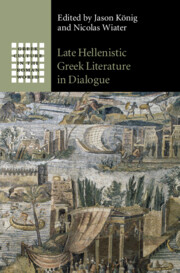Book contents
- Late Hellenistic Greek Literature in Dialogue
- Greek Culture in the Roman World
- Late Hellenistic Greek Literature in Dialogue
- Copyright page
- Contents
- Figure
- Contributors
- Preface
- Abbreviations
- Introduction
- Chapter 1 The Empire Becomes a Body
- Chapter 2 Pyrenaean Mountains and Deep-Valleyed Alps
- Chapter 3 Sailing the Sea, Sailing an Image
- Chapter 4 Ecocritical Readings in Late Hellenistic Literature
- Chapter 5 Civic and Counter-Civic Cosmopolitanism
- Chapter 6 The Wrath of the Sibyl
- Chapter 7 Imagining Belonging
- Chapter 8 Philosophical Self-Definition in Strabo’s Geography
- Chapter 9 Narrating ‘the Swarm of Possibilities’
- Chapter 10 ‘Asianist’ Style in Hellenistic Oratory and Philostratus’ Lives of the Sophists
- Chapter 11 Greek Reading Lists from Dionysius to Dio
- Chapter 12 Envoi
- References
- Index Locorum
- General Index
Chapter 10 - ‘Asianist’ Style in Hellenistic Oratory and Philostratus’ Lives of the Sophists
Published online by Cambridge University Press: 21 April 2022
- Late Hellenistic Greek Literature in Dialogue
- Greek Culture in the Roman World
- Late Hellenistic Greek Literature in Dialogue
- Copyright page
- Contents
- Figure
- Contributors
- Preface
- Abbreviations
- Introduction
- Chapter 1 The Empire Becomes a Body
- Chapter 2 Pyrenaean Mountains and Deep-Valleyed Alps
- Chapter 3 Sailing the Sea, Sailing an Image
- Chapter 4 Ecocritical Readings in Late Hellenistic Literature
- Chapter 5 Civic and Counter-Civic Cosmopolitanism
- Chapter 6 The Wrath of the Sibyl
- Chapter 7 Imagining Belonging
- Chapter 8 Philosophical Self-Definition in Strabo’s Geography
- Chapter 9 Narrating ‘the Swarm of Possibilities’
- Chapter 10 ‘Asianist’ Style in Hellenistic Oratory and Philostratus’ Lives of the Sophists
- Chapter 11 Greek Reading Lists from Dionysius to Dio
- Chapter 12 Envoi
- References
- Index Locorum
- General Index
Summary
In this chapter, I address the question of the relationship between the styles of the non-classicising sophistic prose of the imperial era and the so-called ‘Asianist’ oratory of the Hellenistic period; I also assess the connection of both to the style of Gorgias, with whom they have often been linked. I base my study on a comparison of a limited selection of texts: five of the longest excerpts quoted in Philostratus’ Lives of the Sophists, Gorgias’ Helen and Epitaphios Logos, the fragments of Hegesias of Magnesia (3rd c. BCE), and three late Hellenistic inscriptions. I conclude that, although the passages of Hellenistic and imperial ‘sophists’ undeniably share a broad stylistic similarity that sets them apart from ‘classical’ or ‘classicising’ oratory like that of Lysias, Demosthenes or Dio of Prusa, the differences between them, especially regarding their relation to Gorgianic prose and their preferences for rhythmical clausulae, are more significant.
Keywords
- Type
- Chapter
- Information
- Late Hellenistic Greek Literature in Dialogue , pp. 272 - 318Publisher: Cambridge University PressPrint publication year: 2022

